The LA fires and the 'erasure of heritage'; Wendy's says G'day; beloved diner imperiled; the 'Fat Boy sings'; Catskills history up in smoke | Retrologist Roadside Roundup
Plus, my book, 'The Great American Retro Road Trip,' is available for pre-order. (Woo hoo!) Plus, big headlines from the American roadside.
Before we get down to business, I have exciting news: My new (and first) book, The Great American Retro Road Trip, is now available for preorder! The book takes you on a coast-to-coast journey in search of roadside Americana. While the book hits stores June 24, the best way to support it right now is to preorder it at the online bookstore of your choice. Here are links to Bookshop.org, Barnes & Noble, Amazon, and direct from the publisher, Artisan.
If you’ve followed me over the years here on Substack or on Instagram, I think you’ll enjoy this book as much as I did putting it together for you.
I will have so much more to share about it soon, but I wanted to start getting the word out. It’s the kind of good news that I couldn’t wait to share any longer!
And now, onto the newsletter.
The Los Angeles fires and the ‘mass erasure of heritage’
I’ll come out and say it. Just three simple words that Randy Newman put to song in 1983.
I love LA.
But I won’t stop there, oh no.
I love all of Southern California.
Let me go further.
I love everything that makes California, California, from top to bottom.
I left my heart in San Francisco — Tony Bennett was on to something — but it’s a big heart, and its arteries reach across the awesome expanse of California, from Imperial Beach in the south, Fresno in the middle, and Crescent City in the north. California steals my heart wherever I happen to stand within it. I’m endlessly fascinated by it, no corner too mundane or remote. It’s the one state I have vacationed in the most, visiting again and again at the expense of other places I have yet to see. I may never explore so many wondrous parts of the world because of all the free time I’ve chosen to spend here — and will continue to spend here. And I’m golden with that.
Whenever the headlines scream of wildfires, mudslides, heat domes, droughts, and other calamities that routinely assault California, I cry inside. It pains me to see California, its places, and its people hurt, seemingly more and more with the passage of every year.
But nothing prepared me or any of us for the wildfires of this month, which are still raging. (Rain is now in the forecast, but so is the threat of its devious companion, mudslides.)
Like you, I have watched the incomprehensible destruction fueled by the wildfires: the lives lost or forever changed, the total, Dresden-style erasure of gorgeous, historic communities like Altadena and Pacific Palisades, the wrenching loss of historic homes, attractions, and personal collections, over a century’s worth of a community’s highest expressions of its aspirations, that held so much of the collective story of Los Angeles, that concretized such a lovely vision for what American life can be, simply wiped out. I have watched coverage of the tragedies in homes and businesses erased in mere minutes by indiscriminate flames, the family heirlooms, the art, the antiques, the old love letters, the kindergarten art tacked to the fridge, those things big and small that make a house a home, that shape our lives, all these things — our memory keepers — torched.
My heart goes out to all affected by this ongoing catastrophe.
Moments like this propel us to reach for eloquence, challenging us to verbalize what we feel fully. It is a complex and overwhelming set of feelings and emotions to sift through. I’ll admit that words fail me.
I know that some events can never be fully understood. Consider the abject destruction of 9/11 — as a native New Yorker, I will never accept or comprehend the loss of the original World Trade Center and the thousands of lives that were inside it, all gone in 102 minutes. (And the lives we are still losing from 9/11-related illnesses, with more victims dying since 9/11 than on that day itself.) We learn to live with the loss, along with all the other horrors big and small that assail us throughout our lives. We heal around the scar, but the scar remains. The aftermath of the LA fires is far from arriving at the scar stage — it is a very painful open wound that could still worsen.
This is far from the last I will write about these wildfires — indeed, we’ll be watching the rebuilding of structures, neighborhoods, and lives for the rest of our lives. The running list of historic and notable sites that have been lost is painful and unbearable to read. Here is but one roundup, compiled by the Los Angeles Times, a story of the “mass erasure of heritage,” as put by Adrian Scott Fine, chief executive of the Los Angeles Conservancy.
One place I pray never makes the list is the Vons at 17380 Sunset Blvd. in Pacific Palisades, below. The supermarket survived. It’s one of the few photos I ever took in Pacific Palisades, aside from those on the grounds of the Eames House, which, thanks to our deities of choice, fate, or random turn of wind direction, is still among us.
Yet, for all the ground I have explored in South California, this catastrophe reminds me of so much that I have not seen — and so much I will now never see.
The end looms for New Jersey’s Bendix Diner?
The iconic Bendix Diner in Hasbrouck Heights, New Jersey, was closed earlier this month on order of the health department. The diner has long been a roadside favorite—below is my photo from a 2017 visit—and has earned glowing press over the years partly because of its dynamic and charismatic owner, John Diakakis, a blind man who began working here as a teenager.
The problems center on the diner’s fire-suppression system, Diakakis told the Daily Voice Ridgefield Park-Hasbrouck Heights, an issue he says he’s been wrangling with for years. He says he’s had trouble getting a contractor to help him, and the matter came to a head with the health department shutdown on Jan. 10. He told the paper: “It might be the end of the Bendix Diner."
The community has supported him, helping hunt for experts to bring the place up to code and starting a crowdsourcing drive.
Here’s hoping for good news, and soon. We’ve lost enough Jersey diners, and the loss of this one is unbearable.
The Fat Boy sings — it’s over for a Michigan comfort-food classic
More trouble for an iconic institution — the Fat Boy in Grand Rapids, Michigan, will close in February, the operators announced on Facebook. The owners have accepted an offer for the building, and the new business will not carry on the Fat Boy heritage. I hope the sign will stay in public view. I’ve not yet been and may never get to see it. Above is a report from last year, when it first came out that the business may close. See more photos over at roadarch.com. This business in the Cheshire neighborhood is said to have opened in the 1950s and briefly closed about 15 years ago.

Goodbye to a Gotham Gilded Age holdout
In the Long Island City neighborhood of Queens, we have another closure: Brooks 1890, a bastion of old-world comfort since that year. The space evolved over the decades, starting as a social club, and assumed its current name in the early 1970s. The bar and restaurant offered a faded taste of the Gilded Age in the heart of Court Square. It’s hard to fathom it has closed, but it has, and there are plans for a replacement, an Asian-themed restaurant under new ownership. I can only hope the renovations that are planned will be sensitive to its legacy.
Brooks 1890 was renowned for its historic charm and preserved interior, which featured tiled floors, wood timbers, tin-stamped ceilings, and stained glass. Its centerpiece, a mahogany bar over a century old, stood as a relic of the Gilded Age, while ornate chandeliers and carved ceilings added to the timeless atmosphere. The bar was a gathering place for lawyers, judges, and elected officials who worked at the nearby courthouse, making it a social hub for Long Island City’s legal community.
Chance to shell out for Shell Factory ephemera

The wonderous Shell Factory in Fort Myers, Florida, closed last fall after 86 years. The sign was already in serious disarray when I went by in November. But it’s not too late to own a piece of this relic of Old Florida — items from the attraction are still being auctioned off.
Here is the link to the auction itself, which continues through Jan. 28. Among the items up for bid — and there are hundreds — is a neon sign that hung in the window and a photo board with cutouts for faces shaped like the iconic sign.
‘Where Old Florida is alive and well’ …
While we’ve lost the Shell Factory, another part of Old Florida is still in full bloom: Sunken Gardens in St. Petersburg, which I finally visited last fall. The sign, above, has been beautifully redone, but that’s only the appetizer for the wonders that exist within.
I worked on an ABC Localish profile of Sunken Gardens not long ago, and here’s a lovely profile from Splash Mags.
Lim’s back in the limelight
When I photographed Lim’s Cafe in Redding, California, back in 2021, I knew I was in the presence of roadside greatness. And I was sad to learn it closed the next year. But now, Oriental Express Chinese Food in Shasta Lake is buying the former home of Lims, with plans to open a different restaurant there, and they plan to keep the iconic Lim’s sign, reports the Redding Record Starlight.
A little history I was able to glean: The newspaper traces Lim’s back to a business on Tehama Street in 1933. My research shows the restaurant, under the name Lim’s Chop Suey, was opened in 1950 by Peter Lim. (Lim also ran the House of Lim store that sold Chinese goods that opened in 1940. There was a restaurant beside it called Kim Sing that he opened in 1933.) Lim’s Cafe moved to its existing location in 1957.
First Burgermaster to bite the dust
The original location of the Seattle area burger chain Burgermaster is closing after a 73-year run. The restaurant, in the University District, was founded by Phil Jensen in 1953 and is still in the family. (See remembrances in the Facebook post announcing the closure.) This location was a sit-down restaurant, as opposed to most of the others, which are drive-ins. The overall Burgermaster is a thriving chain, and recently acquired the old XXX Rootbeer restaurant in Issaquah.
Below are the Aurora and Issaquah locations, taken during a book research trip last November:
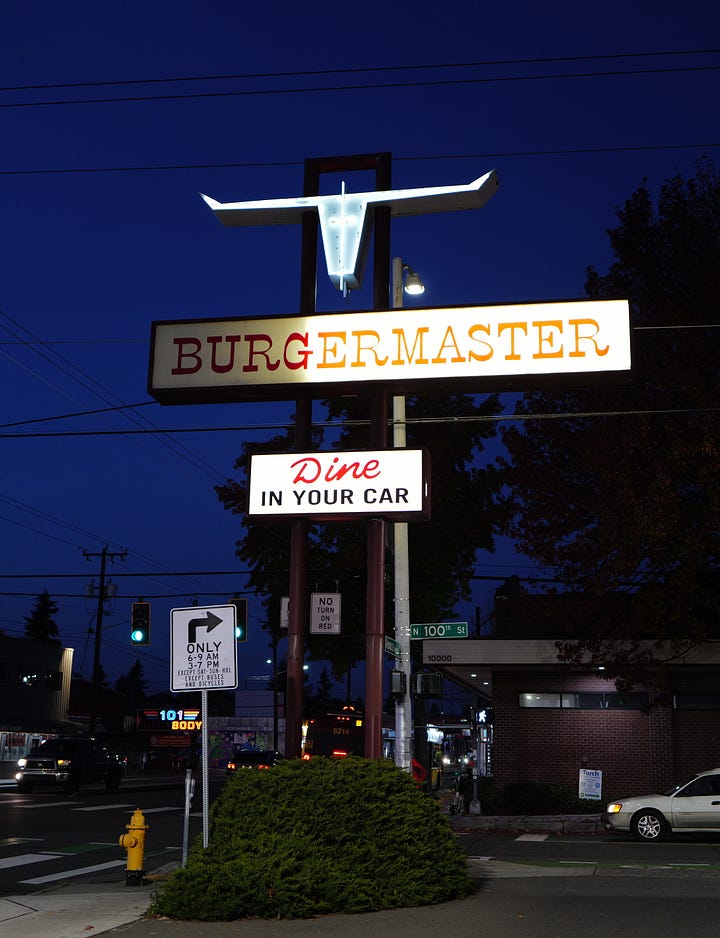

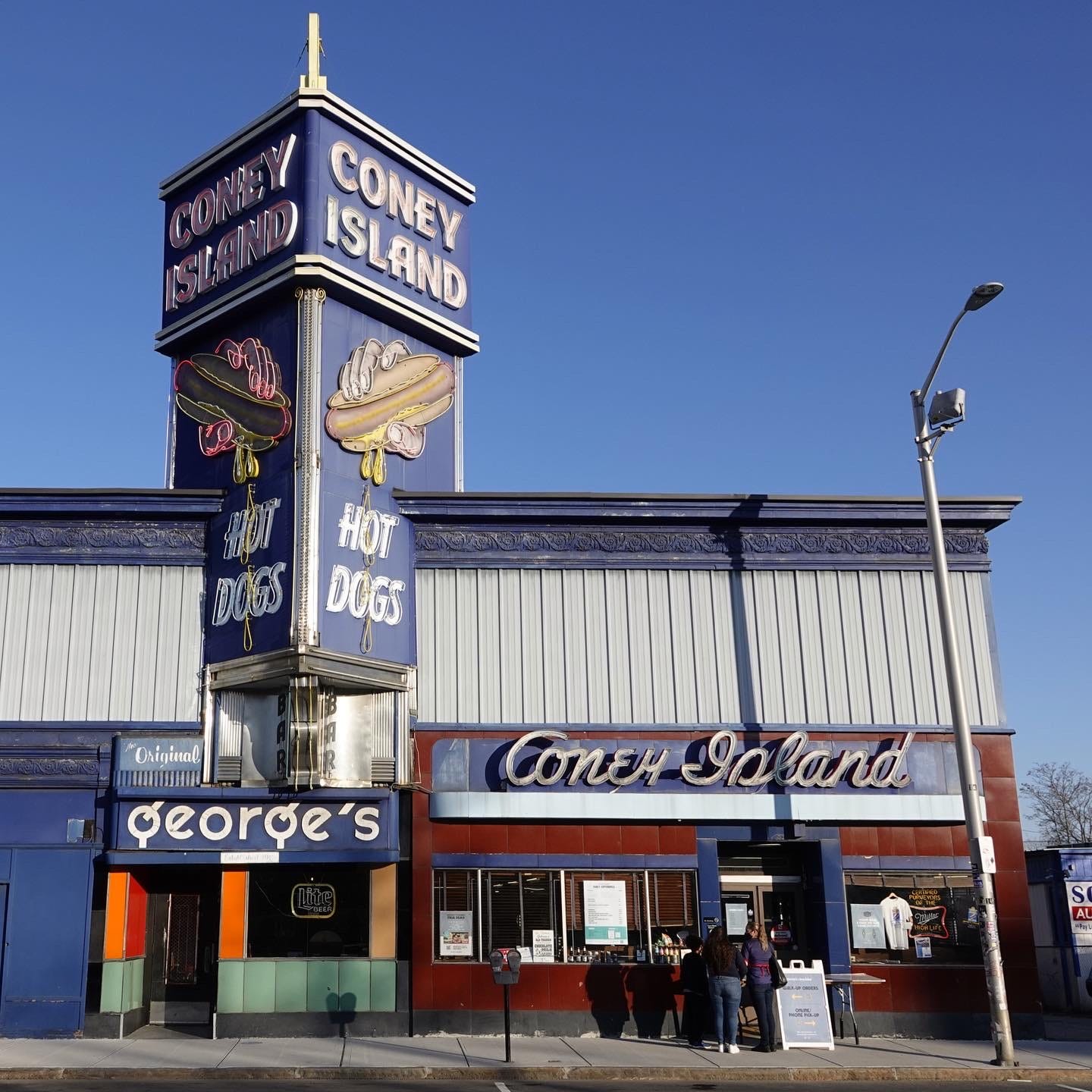
Hot dog! Sign will be shined up
The epic sign for George’s Coney Island in Worcester, Massachusetts, is being restored!
Reports the Worcester Telegram & Gazette:
Arguably as iconic as the delicious hot dogs and straight-backed wooden booths of George’s Coney Island are, is the marvelously tacky 40-foot-high neon sign featuring a gigantic hand holding a humongous hot dog in a bulbous bun dripping illuminated flashes of yellow mustard.
In 1940, the iconic sign, which is Worcester’s equivalent of the Citgo sign over Kenmore Square in Boston, was designed by Russian immigrant S.C. Romanoff and later rebuilt by Stephen S. Kapish, president of Kapp Sign Services Inc.
Dave Waller of Neon Williams is handling the restoration.
Wendy’s says G’day to Australia — again
Wendy’s has returned to Australia for the first time in almost 40 years. The return of Wendy’s proved to be a novelty, sparking long lines, but whether it will be a success is an open question, with stiff competition from Maccas (McDonald's), Hungry Jack’s (Burger King), and other chains.
Wendy’s plans to open 200 restaurants Down Under, much more than the 11 operating at the time they went out of business here in 1985-86, with the remnants of the chain absorbed by Hungry Jack. (Wendy’s Australian parent company at the time, Wenpac, went into receivership in late 1985.)
The first Wendy’s in the Southern Hemisphere opened at Princes Highway, Noble Park, in 1982, according to The Age, so the chain’s initial foray in Australia proved to be short-lived. Will the love be sweeter the second time around?
Note the cool blue, above, used in the new Wendy’s signage, a departure from the red accents that dominate new U.S. locations. Why not, ehem, yellow? See below for more Wendy’s heritage:
After the devastating damage to the Mac’s Golden Pheasant sign as it was being taken down in Elmhurst, Illinois, let’s all work together to save future signs in Chicagoland, like Petey’s Bungalow, which recently closed in Oak Lawn. Follow and support the work of the Chicago Sign Museum, striving to keep this and other forlorn signs in place or, at least, safely removed if they do have to go.
Omega for Alpha Donuts
A radio documentary, above, is exploring the “lingering loss” of Alpha Donuts in Sunnyside, Queens. I have not quite gotten over its demise, either.
Below, see my requiem from 2023 for this very special coffee shop.
Hole left in our hearts: Beloved NYC donut shop closes after 48 years
Everything in life has an Alpha and an Omega, a beginning and an end.
Fire at the old Nevele Resort in the Catskills
The future of the iconic and long-shuttered Nevele Resort in Ellenville, New York, in the Catskills, is all the more grim after a fire earlier this month destroyed part of the main building, a tower widely seen in long-running New York-area commercials. This is the second fire at the resort in the past year.
The old-school Borscht Belt resort was famed for its catchy commercial jingle, “At the Nevele.”
I digitized the commercial back in 2016, when I was running the WPIX Archives Facebook page I founded the year before. Watch the winter version of the ad here, and here’s the summer version.
It’s funny that New York’s Channel 11 ran the ad so much because the lore has it the name Nevele is “Eleven” spelled backward. Per Wikipedia: It was named “after the eleven nineteenth-century schoolteachers who discovered a waterfall within the present-day property. Also (according to family lore), the founder, Charles Slutsky, had eleven children from 1880 to 1906 and the name might have come from that instead.”
Duly Noted!
Joe Marzilli’s Old Canteen in Providence, Rhode Island, has closed, a Federal Hill fixture since 1956.
Asheville, North Carolina’s “fancy McDonald’s” was destroyed during Hurricane Helene, and plans have been submitted to rebuild it. The Biltmore Village McDonald’s opened in 1971, and the current structure dates to 2000. That building honors the architectural design of the great Biltmore estate nearby, as do the other buildings in Biltmore Village, all by design. The new plan McDonald’s has submitted for the successor building has been described as “modern,” causing consternation. "The whole idea of Biltmore Village is that it looks like a European village," Historic Resources Commission Chair Sioux Oliva said, according to the Citizen Times. Whatever happens with the design, the ever-popular piano will be coming back.
Meanwhile, McDonald’s CosMc’s spinoff is closing half its locations in Texas, but more are reportedly on the way to the Lone Star state.
And more fast-food news: In-N-Out is coming to Portland, Oregon.
Congrats to Henry’s Diner in Burlington, Vermont, which is celebrating its 100th birthday!
Still ugly? Boston’s Brutalist City Hall has been declared a landmark. (I don’t think it’s ugly.)
Jerry’s 637 Diner on Staten Island made it to its 71st year. It has closed and the owner is selling the building.
The iconic former Wanamaker’s in downtown Philadelphia is among a slew of Macy’s set to close. The historic organ is staying put.
The stomach-turning reasons this beloved Upper West Side, Manhattan, market was closed.
Inside Tahoe City’s oldest log structure, the Watson Cabin.
Hawaii’s historic Chart House Waikiki, dating to 1968, has reopened after a renovation.
.
Hope for the shuttered and beautiful Suzie Q’s Cafe in Mason City, Iowa.
A visit to St. Louis’ Chili Mac Diner, a downtown institution since 1904.
The Colonnade, Atlanta’s second oldest restaurant, is expanding its hours.
Zum Stammtisch, the historic German restaurant in Glendale, Queens, is shutting its pork store after 11 years, but the cherished restaurant, which opened in 1972, isn’t going anywhere.
Long Island’s last duck farm has to cull all of its ducks — around 100,000, because of a bird-flu outbreak. (We’ve met the Big Duck before, the biggest and boldest relic of what was once a thriving industry out East. See below.)
Rolando's Roadside Roundup: Big Duck Edition
Back on a muggy August day, Brittany Winderman, my WABC-TV colleague, and I packed into a news van and headed from the bustle of 7 Lincoln Square to the countryside calm of Flanders, New York, on Long Island’s East End, where The Big Duck awaited us.
The Wolfman Pizza in Charlotte, North Carolina, in Cotswold Village, has closed. That leaves one more, in Quail Corners.
The owner of a historic motel and restaurant in Longview, Texas, is hoping for a miracle reprieve as she faces demolition of the long-shuttered structures.
The American Sign Museum needs your help to restore the Frisch’s Mainliner sign it rescued last month. I shared news about this a few weeks back.
Frisch's Mainliner: Farewell to the fabulous flagship of this Big Boy chain
·When I visited Frisch’s Mainliner in Fairfax, Ohio, back in October 2022, I wasn’t the least bit concerned about its future. This location, and the overall Frisch’s Big Boy chain, seemed healthy, and the Mainliner was the pride of the fleet, where Dave Frisch in 1939 founded his own Mainliner restaurant — Cincinatti’s first year-round drive-in — and eventually allied it to the Big Boy franchise he secured from Bob Wian, the founder of Bob’s Big Boy. Frisch’s Big Boy expanded rapidly and became the biggest Big Boy operator, bigger than Bob’s itself.
Gilley’s Diner in Portsmouth, New Hampshire, has reopened.
The revival of Gene’s Tasty Burger in Wichita Falls, Texas, was sadly short-lived and now a new restaurant, El Chaton, is moving in. We can only hope the sign is preserved or saved and kept on public view.
You’d be a “nut” to turn this job down. Planters Peanuts is looking for somebody to drive the NUTmobile for a cool $45,000. For some that might be peanuts, but the memories of the job (and the book you can squeeze out of it) would be priceless. You can apply here.
A visit to Rao’s Bakery in Beaumont, Texas, since 1941. (I missed this sign on my visit here in 2023!)
Historic Briarhurst Manor in Manitou Springs, Colorado, has closed. Business in 2024 collapsed, forcing the decision.
Johnny’s Navajo Hogan, closed for several years, is now for sale. The Manitou Springs institution, dating to 1935, is on the market for $1.4 million. It is listed on the National Historic Registry and the Colorado State Register of Historic Properties.






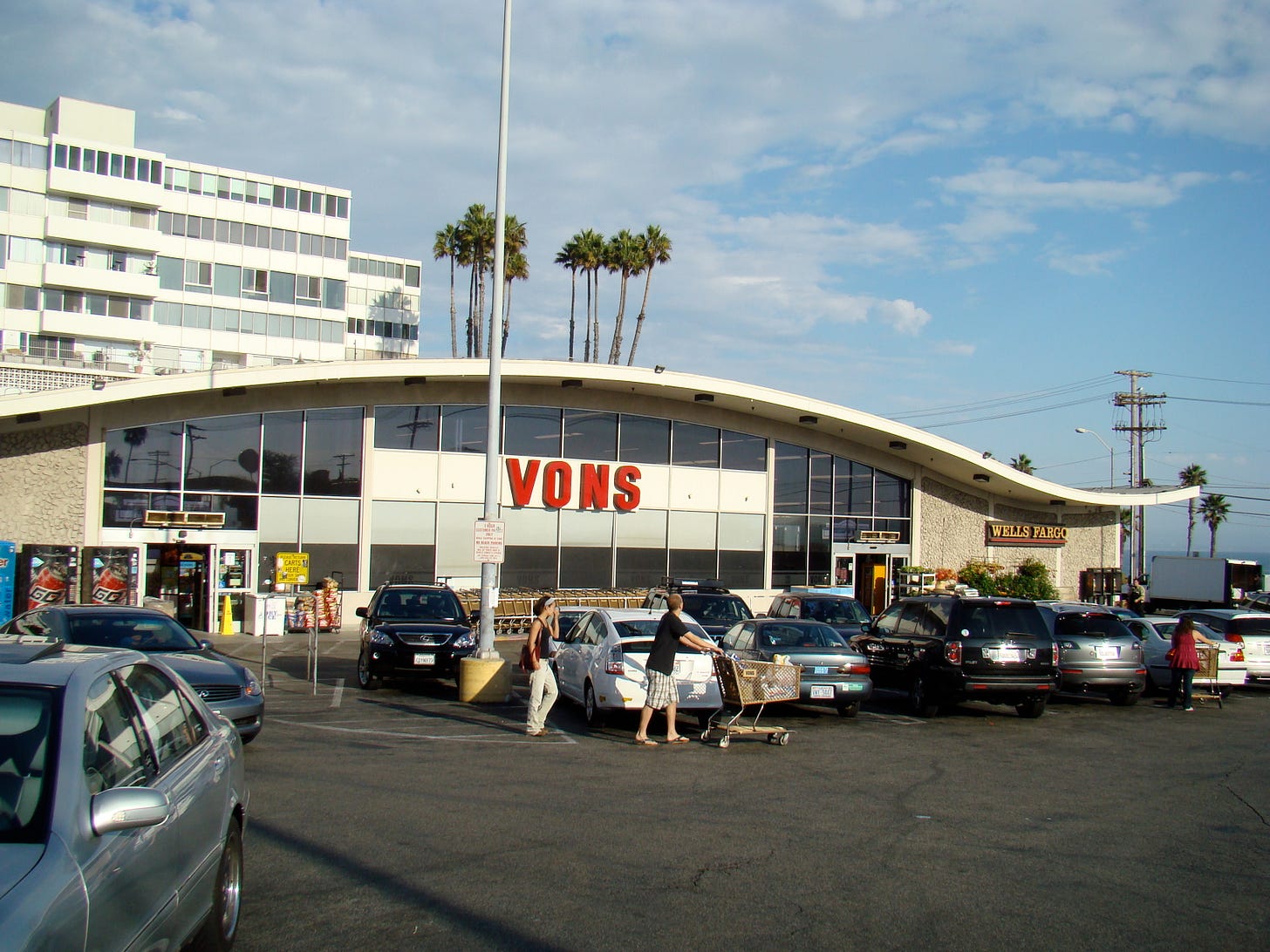
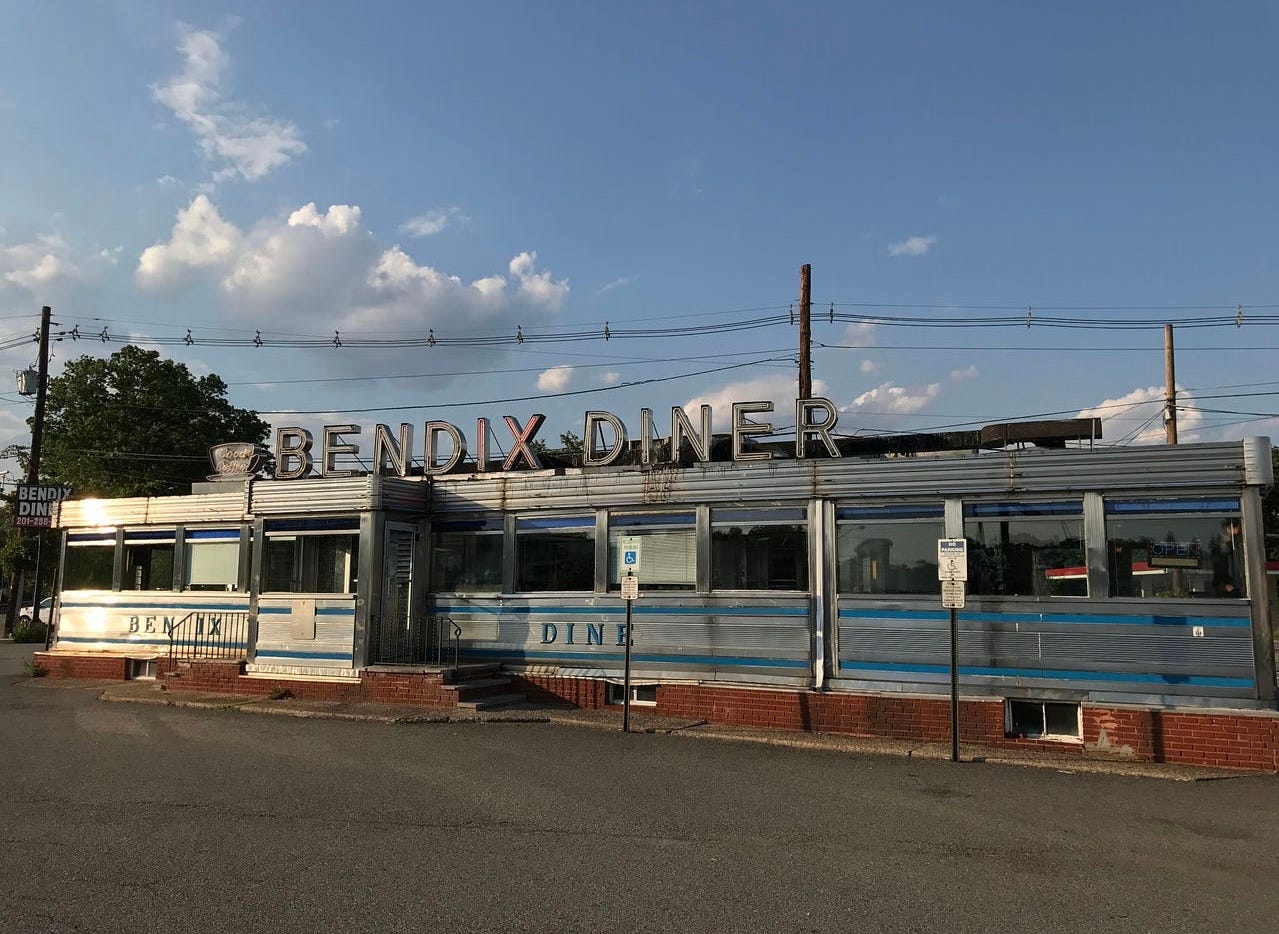
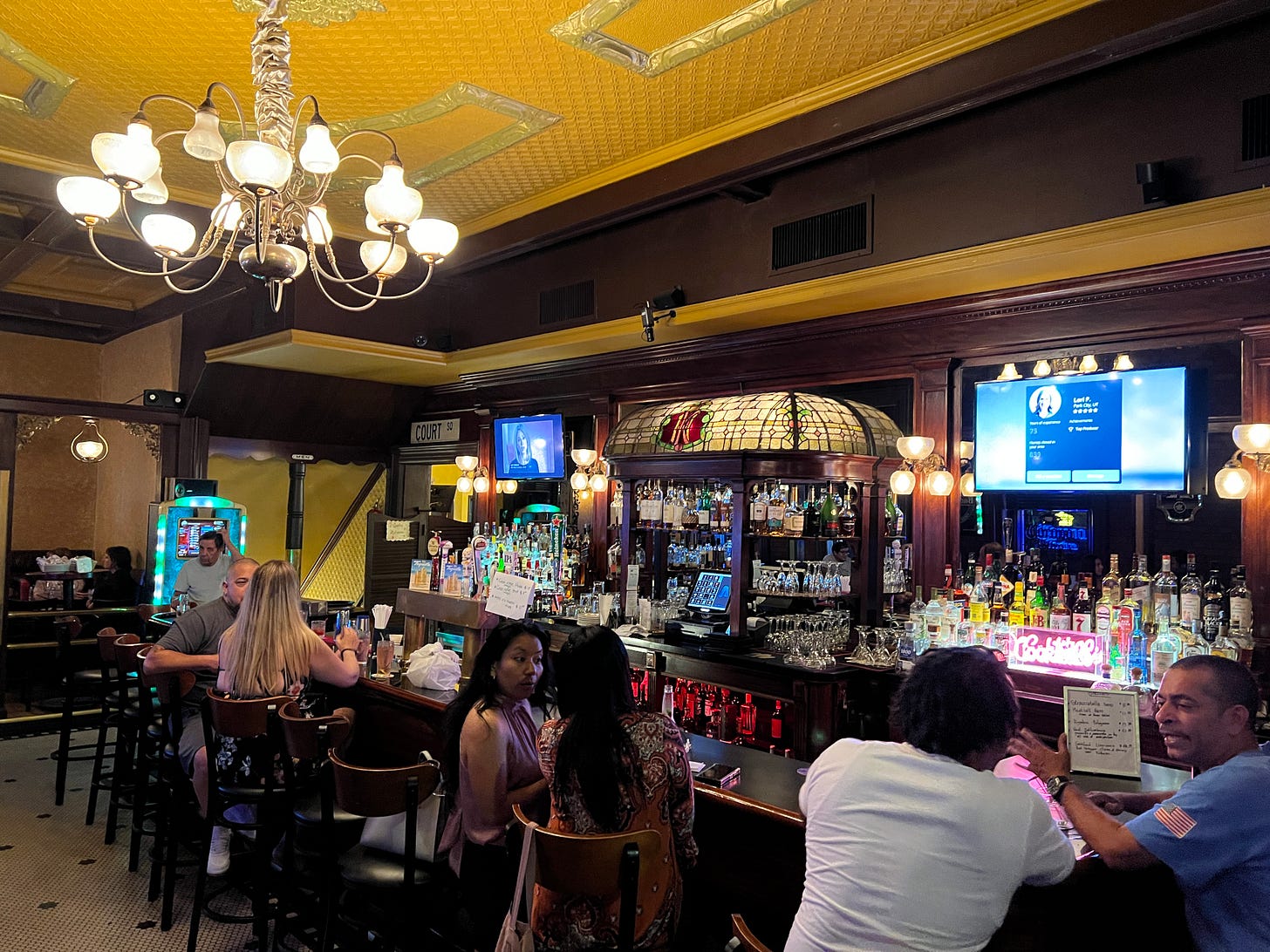

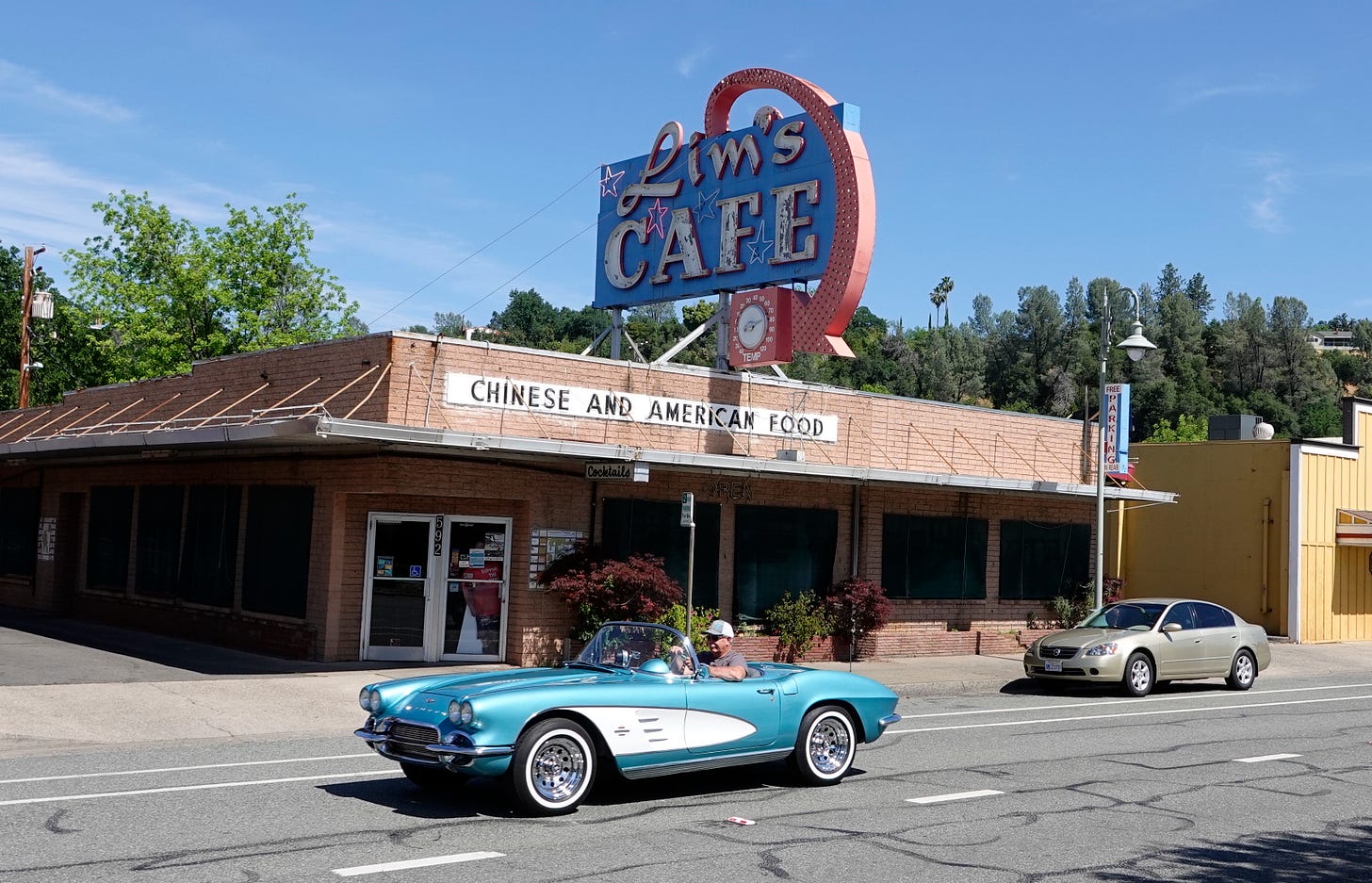

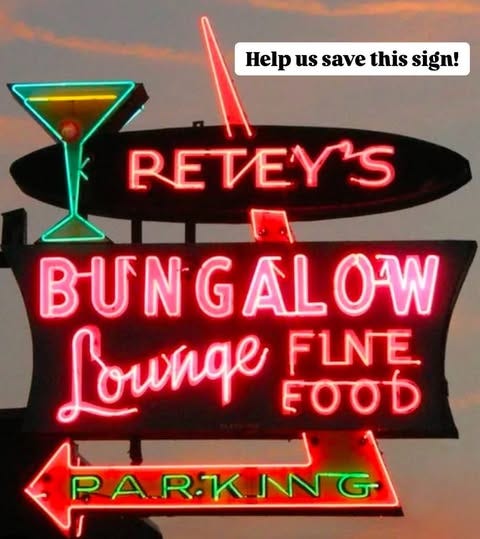






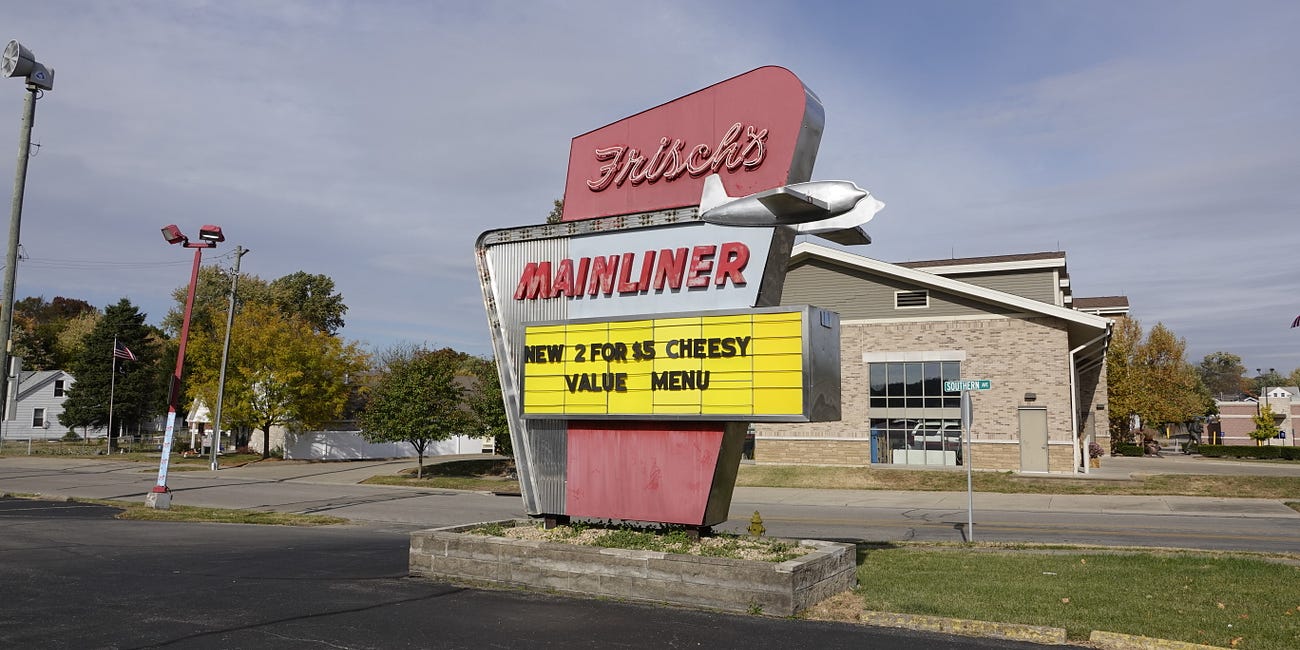

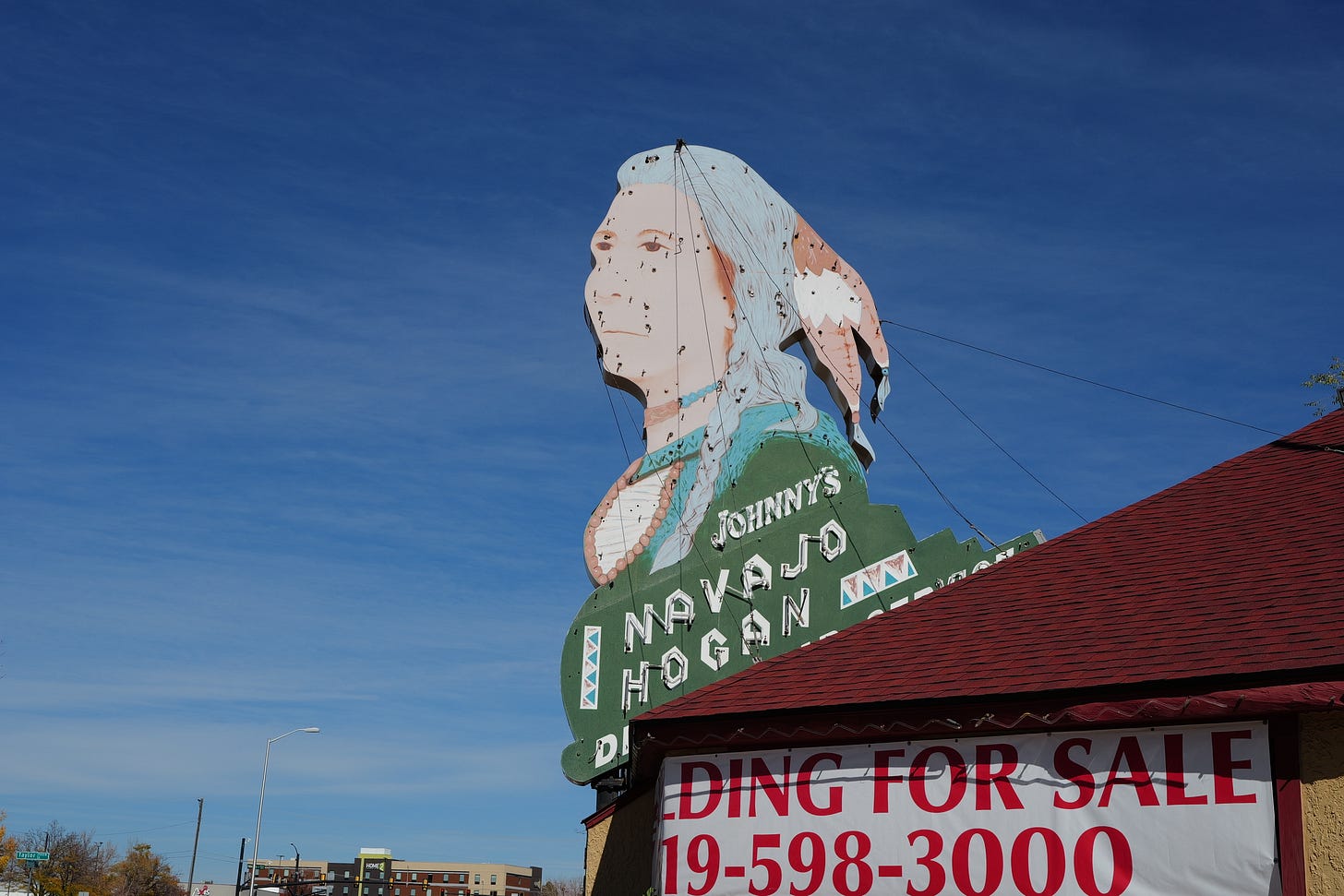
Congrats on the book! Looking forward to it.
Wow. Brooks and Joe Marzilli's.